When I'm about to jump into a big project, I love to get background information. In this case, I borrowed Chanel and Her World from the library and spent three days immersed in it. Before this project, I knew very little about Coco Chanel. But when I laid eyes on the book's cover image, with that controlled glance over the shoulder, the draping strands of pearls, the not-carelessly-dangled lit cigarette -- well, this is the image I associate with her:
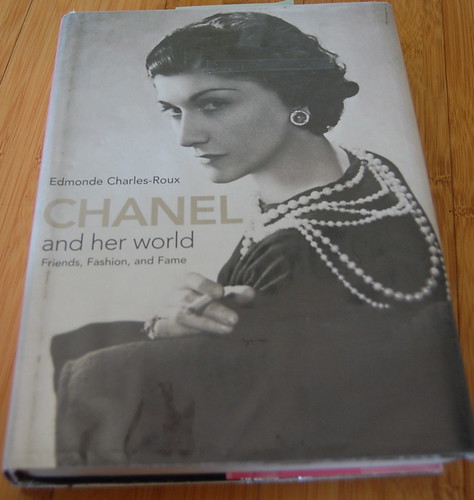
I'm so glad I read this book! I was looking for specific clues as to what inspired Karl Lagerfeld to design the Pre-Fall 2009 collection (i.e. "Paris-Moscou"), which debuted last December, from which my inspiration garment comes. I knew there was a so-called "Russian period" in Chanel's career, but I didn't realize how many styles she is credited with pioneering or bringing to popularity, such as a functional swimsuit. Until Chanel's efforts, the swimsuit was made of wool (!!!) and was basically impossible to swim in. ("All the better to oppress women with" was apparently the societal mantra of the day.) This is one step better than wool, as worn by Chanel at the beach in 1914:
I love that the suit above was a huge improvement over the traditional version in wool! Chanel kept streamlining that swimsuit to what is essentially a one-piece suit with boy-short-style bottoms. Not the cheek-baring boy short of today, but longer, like mid-thigh (I guess more biker-short?).
Chanel is credited with bringing the cape to popularity. It is interesting to me how the capes fastened using this harness-like contraption, because harnesses and "cage" elements are ever-present in recent shows:
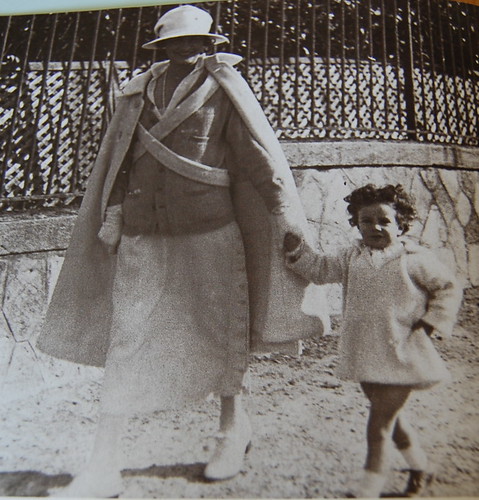
Chanel had a famous affair with the Duke of Westminster, then the richest man in England, and incorporated a taste of the English countryside into her designs. Here she is, on the left, sporting some oversized tweed. Street urchin chic, I say:
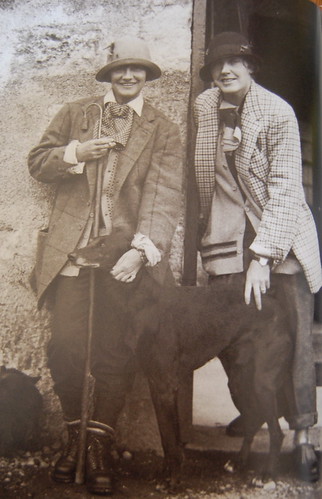
There is just a tiny section on her Russian-influenced years 1920-1923, during which, again, she had an affair -- this time with Grand Duke Dimitri Pavlovitch -- that brought her to Russia. Here is Pavlovitch, and funny enough, the general military feel is very familiar in my inspiration jacket:

Chanel introduced some of that Russian influence in her next collection, pulling in both "high" (fur) and "low" (peasant blouses) traditions. Here are some sketches from that collection:
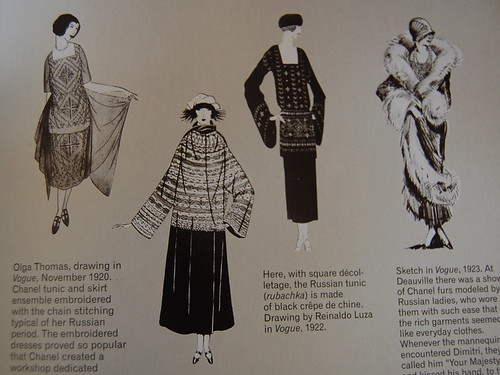
Seems that Chanel's Russian collection featured more of the beautiful traditional Russian embroidery and not so much of the blinged-out embellishment of Lagerfeld's Paris-Moscou. Not that I'm critical of Lagerfeld's choices -- obvz. I'm OK with at least one of those jackets since it is my inspiration jacket. :)
There were so many beautiful clothes sketched and photographed in this book, and most of them were pre-1950's, before the period of Chanel's iconic jacket. In this Russian collection you could already see some trace of that iconic jacket coming into form, though. Below is a sketch from the Russian collection in 1923, and while you see some opulent furs, what caught my eye was the white jacket in the middle, with the contrast trim around the neckline, front placket, and sleeves:

OK, back to the hunt for clues to my inspiration jacket... I kept a careful eye out for anything Chanel designed that would qualify by today's standards as over-the-top. The closest I came were some pictures from her beautiful pre-WWII Gypsy collection from 1938, which seem more over-the-top when compared to her previous work, not really by today's standards:
It blew me away to see the photo above, right -- I think I have worn outfits like this in the past couple of years! So modern. I guess so timeless.
Some of you are probably Chanel experts and you know all these photos and what pages they're on in the book! But this was mostly new for me, and I recommend this book if you want to get grounded in Chanel. I'd love to pick up another biography later, maybe after the sew-along, to find out more about her affair with the German officer that branded Chanel a Nazi sympathizer (there we go with the affairs again) -- this was pretty much glossed over in this book; to get another perspective on the totality of her influence on modern fashion; and to dig deeper into the sweeping changes in culture and society that took fashion from the hands of mostly female designers in the early 20th century to mostly male designers by the middle of the century.
I think I've picked out my pattern and I've been hunting faithfully for a wool jacket to recon into my Chanel jacket, but it may not work out and I may need to make this jacket from new fabric. I'll give it another week or two and post an update.
*** Update *** Nancy K. brought to my attention that the Grand Duke was in exile in France, which is likely how he and Chanel connected. I re-read the Russia section in this book and it implies the same, so I remembered it wrong when I posted yesterday! Thanks for the correction, Nancy K. :)


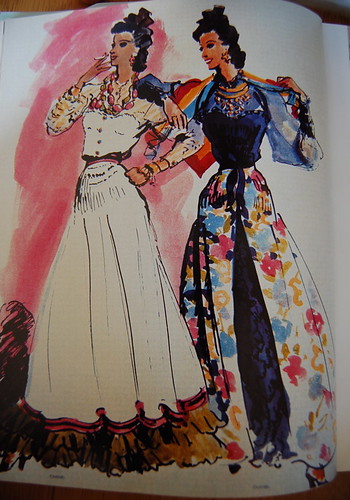
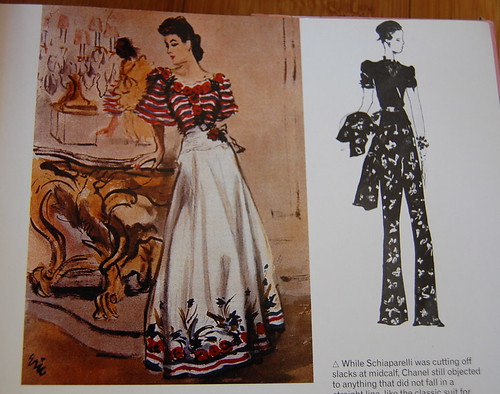

Wow, thanks for this wonderful post, Antoinette! I am by no means anywhere close to a Chanel expert, and I've seen this book before and wondered about it. Thanks for the comprehensive look into it.
ReplyDeleteThis is a great book to get to know Chanel as a woman and enables you to better understand and appreciate her designs. I'm just going to admit it now and say I can't help but wonder what she would think today if she saw the direction her label has taken under Karl Lagerfeld. Another book you might enjoy is Chanel Collections and Creations - some history but great inspirtional photos.
ReplyDelete@Gertie - I'm glad this was the first I got my hands on -- easy reading and beautiful photos. Looking forward to the next one!
ReplyDelete@Elizabeth - I bet for any of the masters, it would be hard to let go of creative control of your own label. Even though I don't like every collection that's come from Chanel, I actually think Karl Lagerfeld has done as good a job as anyone could have of honoring its legacy and still trying to push forward. Thanks for suggesting Chanel Collections and Creations! I will look for it.
Just a historical comment, the Russian revolution took place in 1917 and the Grand Duke was in exile in France, which is where I assume they met. She also was associated with another Russian exile, Ernest Beaux, who in 1920 created her famous perfume, Chanel No. 5.
ReplyDelete@Nancy K - Yes, I remember reading that many Russians were in exile in France, and that the aristocrats frequented her atelier and others became models for her. I also remember reading, though not in this book and I can't remember where, that the Grand Duke's sister owned a shop that specialized in embroidery, and that Chanel was eager to outsource the embroidery work on the collection to the sister. ???
ReplyDeleteThank you for this great post --- really informative and I'm looking forward to finding that book!
ReplyDelete